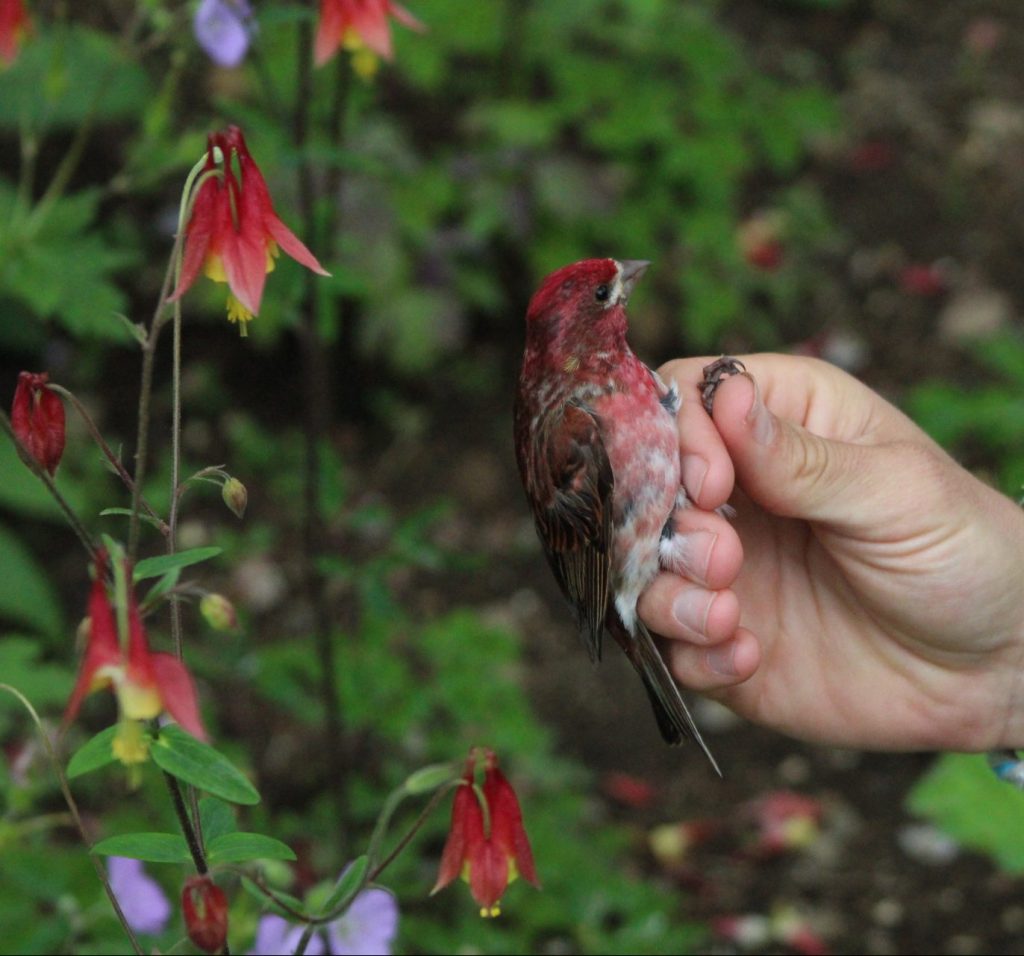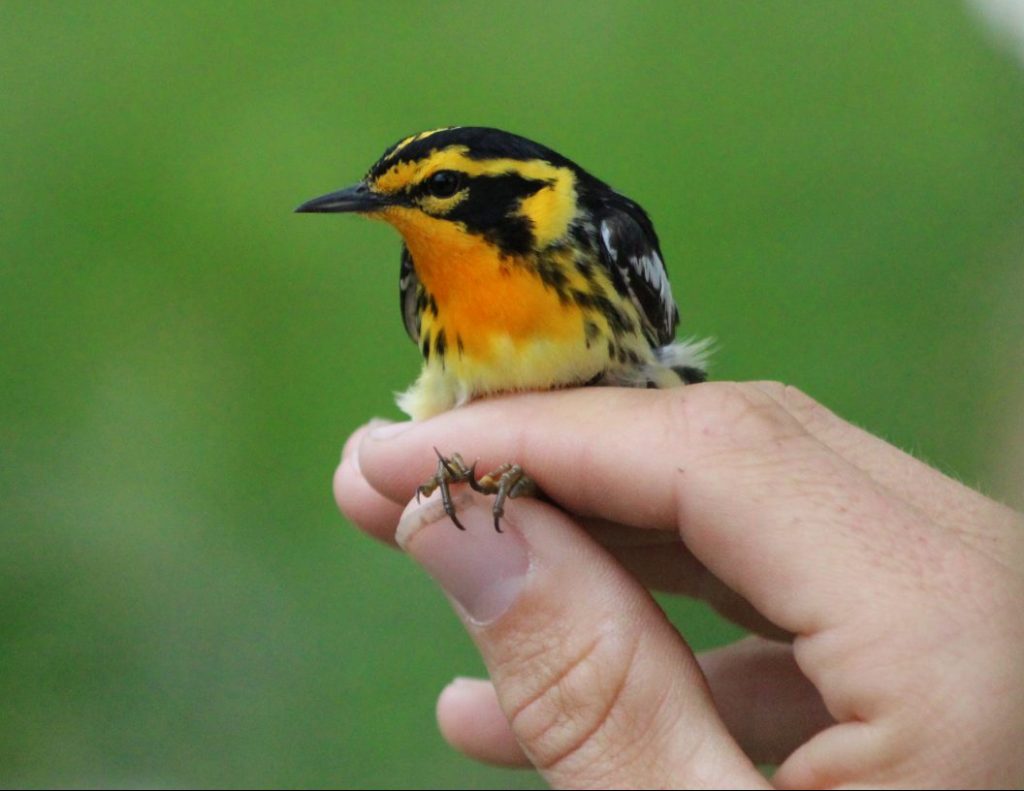I was very fortunate to have the opportunity recently to spend a morning doing one of my very favorite things in the world . . . banding birds.
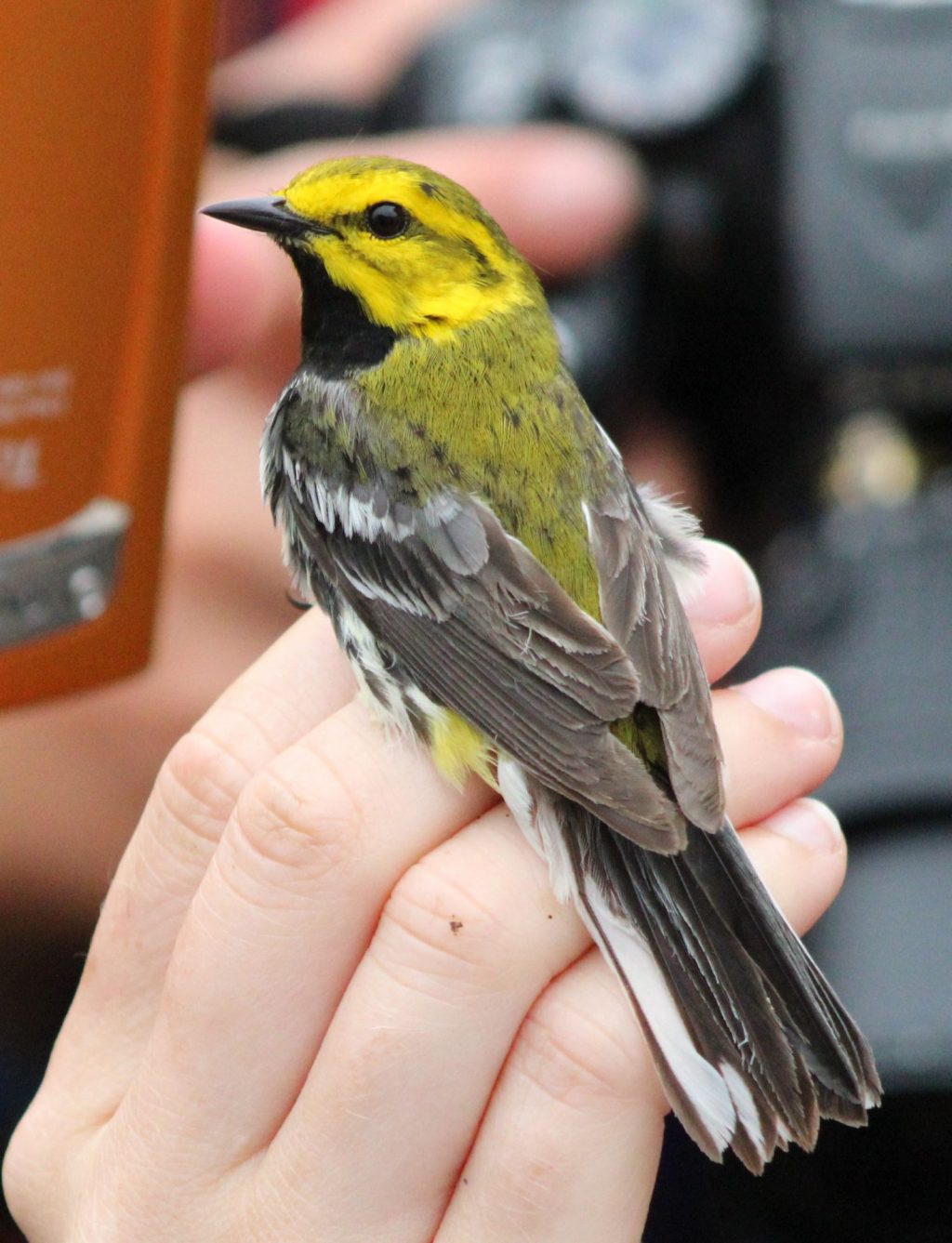 I find nothing more magical than seeing up close these brightly plumaged wonders of nature which are usually encountered only in brief glimpses, through binoculars, as they flit from branch to branch, foraging among the treetops.To hold a tiny songbird and reflect upon how so dainty a creature (many weigh no more than a dozen paperclips) can make nighttime flights of hundreds of miles, can navigate to another continent despite having never made that journey before, can spend six months thousands of miles away only to return the next spring to the same forest in which it was born . . . it’s nothing short of miraculous.
I find nothing more magical than seeing up close these brightly plumaged wonders of nature which are usually encountered only in brief glimpses, through binoculars, as they flit from branch to branch, foraging among the treetops.To hold a tiny songbird and reflect upon how so dainty a creature (many weigh no more than a dozen paperclips) can make nighttime flights of hundreds of miles, can navigate to another continent despite having never made that journey before, can spend six months thousands of miles away only to return the next spring to the same forest in which it was born . . . it’s nothing short of miraculous.
Indeed, I was ten years old when I first held a bird in my hand–at a small banding facility in the mountains of Central Pennsylvania–and it was that moment that turned me into a lifelong birder. I remember that it was a thrush, a Swainson’s I believe, and as its tiny heart raced against the grasp of my small fingers, mine almost leapt out of my chest. I also still vividly recall the excitement that fall–from both the college students banding that day and their ornithologist professor–when they netted a small Sharp-Shinned Hawk, not a terribly unusual sighting at the peak of their migration season, but a wary and agile bird that is rarely caught in mist nets.
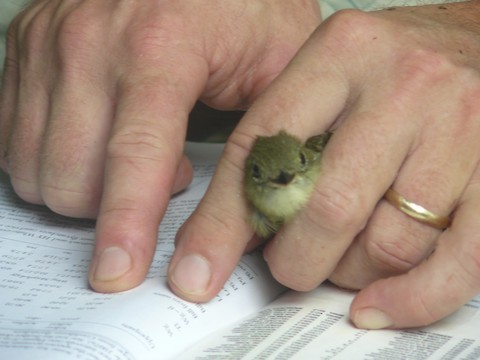 Banding is also what first brought me in contact with Irvine, many years ago. As a graduate assistant at Penn State, I had spent an entire summer banding several times weekly, as part of an on-going ten-year research project on avian communities in mixed-oak forests. The tedium of data entry and analysis aside, the experience made an indelible impression upon me–so much so that I, as a raggedy 23 year-old, actually looked forward to getting up at 5 am to open the nets, literally hours before my apartment mates roused from their slumber. As odd as some of my friends found it, these close encounters with feathered fauna were my drug, and I was clearly addicted. Even before I relocated to the Baltimore area a year later and started teaching mathematics, I had scoured several banding journals to find out where in Maryland they banded. I was overjoyed to read that a small operation at St. Timothy’s School (a.k.a Irvine’s original location) was just a few miles from my new home. As a new school year also coincides with a new season of migration, I took advantage of the first sunny Saturday to wake up early, head up Greenspring Avenue, and introduce myself to the small group of dedicated banders–comprised most days of two retired volunteers and one Irvine naturalist. Over the next five or six years, I went out several times each fall and again each spring (often with five or six Middle School students in tow) to lend a hand and relive the sublime experience of seeing–and really studying–birds on a level that most people, sadly, will never get to experience. Banding is a very labor-intensive undertaking and requires a great deal of training and government certification. The old banding program at Irvine went by the wayside twenty-some years ago, and today only a handful of banding operations exist in Maryland.
Banding is also what first brought me in contact with Irvine, many years ago. As a graduate assistant at Penn State, I had spent an entire summer banding several times weekly, as part of an on-going ten-year research project on avian communities in mixed-oak forests. The tedium of data entry and analysis aside, the experience made an indelible impression upon me–so much so that I, as a raggedy 23 year-old, actually looked forward to getting up at 5 am to open the nets, literally hours before my apartment mates roused from their slumber. As odd as some of my friends found it, these close encounters with feathered fauna were my drug, and I was clearly addicted. Even before I relocated to the Baltimore area a year later and started teaching mathematics, I had scoured several banding journals to find out where in Maryland they banded. I was overjoyed to read that a small operation at St. Timothy’s School (a.k.a Irvine’s original location) was just a few miles from my new home. As a new school year also coincides with a new season of migration, I took advantage of the first sunny Saturday to wake up early, head up Greenspring Avenue, and introduce myself to the small group of dedicated banders–comprised most days of two retired volunteers and one Irvine naturalist. Over the next five or six years, I went out several times each fall and again each spring (often with five or six Middle School students in tow) to lend a hand and relive the sublime experience of seeing–and really studying–birds on a level that most people, sadly, will never get to experience. Banding is a very labor-intensive undertaking and requires a great deal of training and government certification. The old banding program at Irvine went by the wayside twenty-some years ago, and today only a handful of banding operations exist in Maryland.
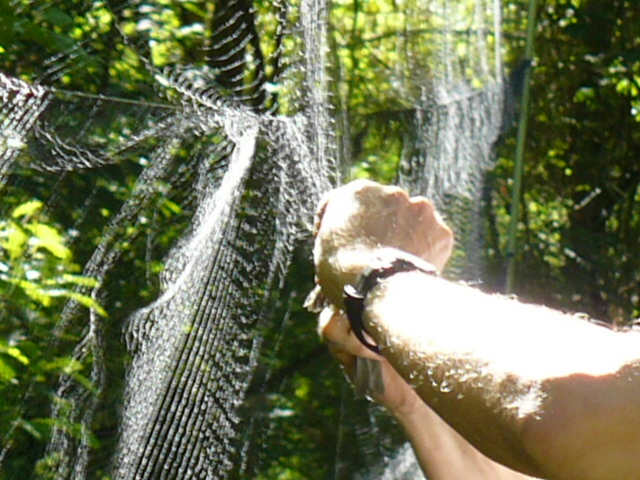 The banding process has a long history, which hasn’t changed all that much over the past century. Many of today’s methods of capturing birds remain from decades past. For songbirds, the standard is mist nets–very fine netting strung between poles, with tiers of pockets, into which flying birds fall as they hit the netting. As long as they are not left for long periods of time in direct sunlight, extreme cold, or the view of a nearby predator, the process is relatively harmless for the ensnared. Nets are generally checked every hour and most birds can be untangled by an experienced bander in well under a minute. Larger birds–especially waterfowl and shorebirds, as shown in these linked videos–are often captured in boom or rocket nets, which are propelled via mini ‘cannons’ over top of flocks that have gathered in the water or along a shoreline. It’s a much more complicated and expensive process than mist-netting, but one that can gather a large number of study subjects all at one time.
The banding process has a long history, which hasn’t changed all that much over the past century. Many of today’s methods of capturing birds remain from decades past. For songbirds, the standard is mist nets–very fine netting strung between poles, with tiers of pockets, into which flying birds fall as they hit the netting. As long as they are not left for long periods of time in direct sunlight, extreme cold, or the view of a nearby predator, the process is relatively harmless for the ensnared. Nets are generally checked every hour and most birds can be untangled by an experienced bander in well under a minute. Larger birds–especially waterfowl and shorebirds, as shown in these linked videos–are often captured in boom or rocket nets, which are propelled via mini ‘cannons’ over top of flocks that have gathered in the water or along a shoreline. It’s a much more complicated and expensive process than mist-netting, but one that can gather a large number of study subjects all at one time.
Among other uses, banding is utilized by ecologists to estimate relative population sizes. Just as 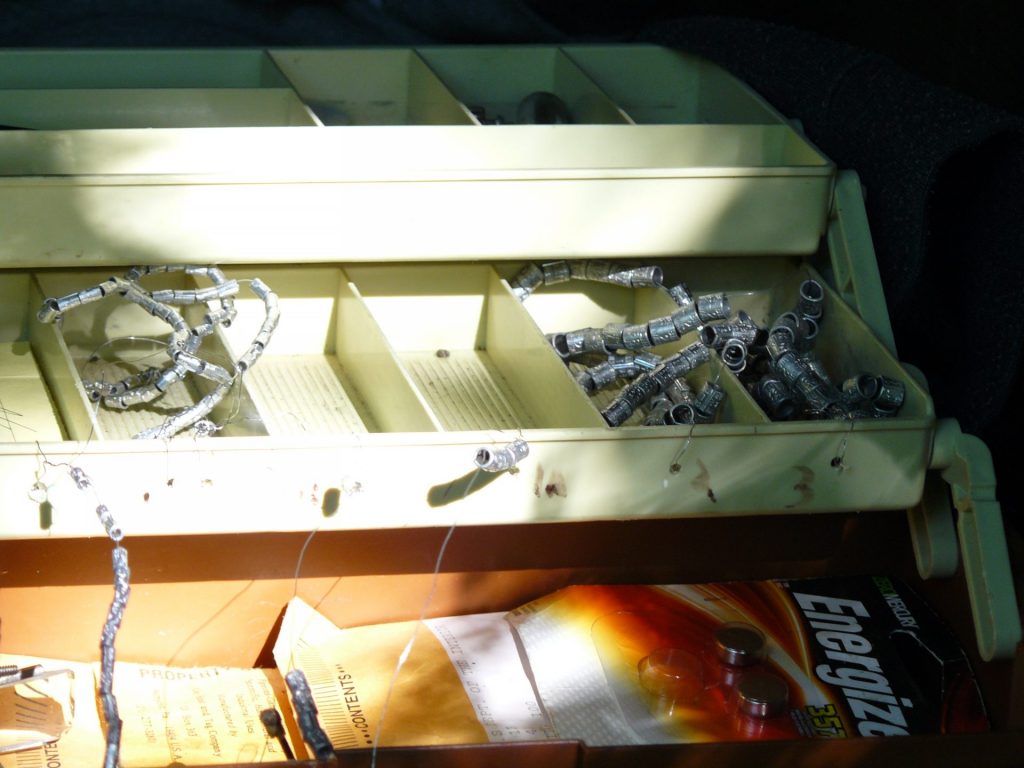 they do with tagging or marking other species of animals, researchers use the bands (or rings as most Europeans call them) as identifiers to distinguish individuals from one another. (It may sound ‘species-ist’ but, to most of us anyway, all Song Sparrows look alike.) The mathematics involved (direct proportionality) is simple enough for many school children to follow. Keeping with ‘tidy’ numbers, let’s say that over the course of several weeks a scientist bands 30 of said sparrows that are over-wintering in some extensive marsh. A little later that season, she goes back out for another round of mist-netting; that time, she captures 40 sparrows, eight of which are ‘returns’ wearing her previously-placed bands. The fairly logical assumption would be that the ratio of banded individuals in this recaptured sample should be fairly representative of the ratio of banded sparrows in the entire population. Thus:
they do with tagging or marking other species of animals, researchers use the bands (or rings as most Europeans call them) as identifiers to distinguish individuals from one another. (It may sound ‘species-ist’ but, to most of us anyway, all Song Sparrows look alike.) The mathematics involved (direct proportionality) is simple enough for many school children to follow. Keeping with ‘tidy’ numbers, let’s say that over the course of several weeks a scientist bands 30 of said sparrows that are over-wintering in some extensive marsh. A little later that season, she goes back out for another round of mist-netting; that time, she captures 40 sparrows, eight of which are ‘returns’ wearing her previously-placed bands. The fairly logical assumption would be that the ratio of banded individuals in this recaptured sample should be fairly representative of the ratio of banded sparrows in the entire population. Thus:
8 BANDED out of 40 SAMPLED ≈ 30 BANDED INITIALLY out of ??? in the entire POPULATION
In other words, since she found that 8/40 or 1/5 of her sample birds were already banded, then it is quite likely that she must have initially banded approximately 1/5 of all of the Song Sparrows. Since she banded 30 initially, she could predict, with some degree of accuracy, that the overall population of Song Sparrows wintering in that marsh system is around 150. Of course, this is a vastly simplified example of the process known as ‘Capture-Mark-Release-Recapture,‘ which has been used for decades as a means of estimating the size of wildlife populations. In the ‘real world,’ all sorts of additional variables would come into play. (Were there any major winter weather events in the interim which would’ve affected the number of sparrows? Is there currently any noteworthy immigration of new sparrows into the marsh or reasons to believe that sparrows are emigrating away? Has there been any discernible change in food resources available to the birds since the initial banding period? Etc.) In general, the method works best, obviously, in closed systems (isolated habitats with little or no migration of organisms in nor out.) For greater accuracy, it 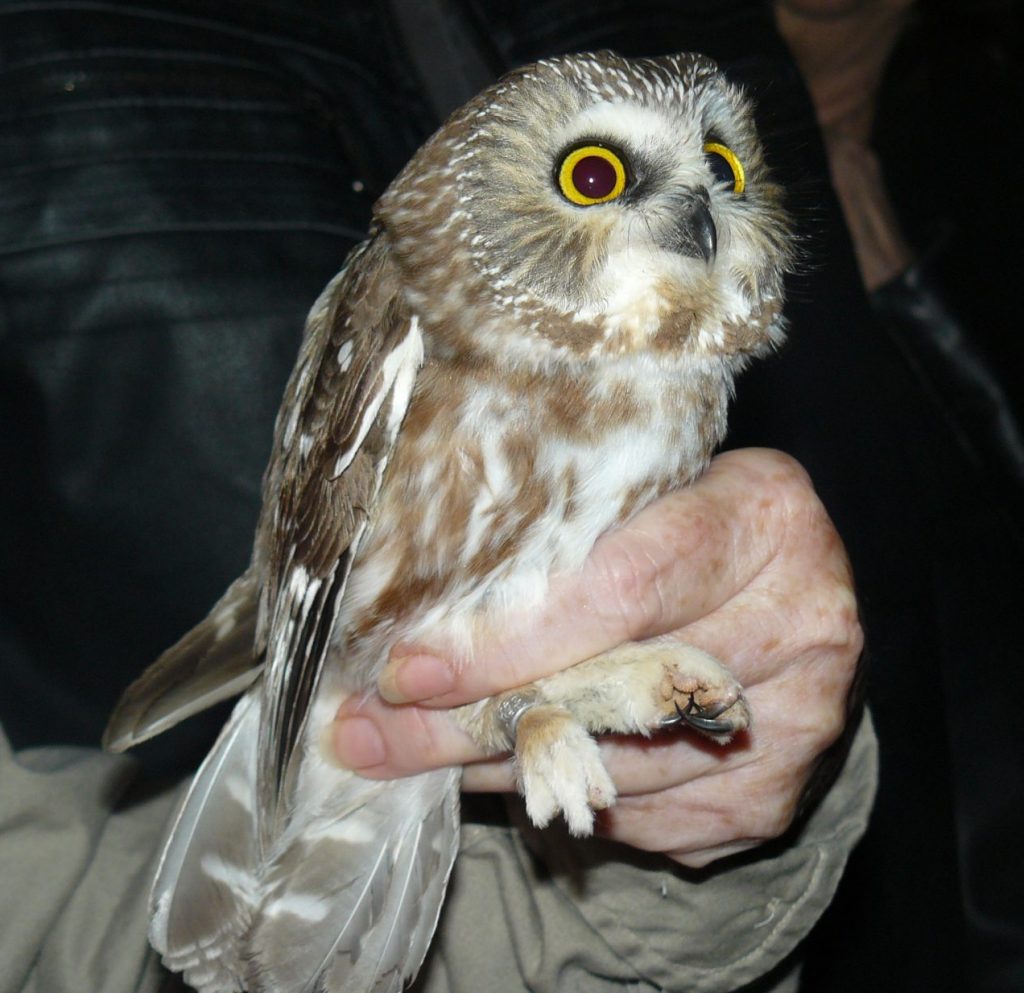 is important that the method of marking individuals cannot easily be removed by the animals and that the method of capturing does not alter the randomness of the chance of being caught. (For example, if animals are lured in with food, recaptures of tagged individuals may become artificially high, as they learn that there’s a free meal waiting for them and come to realize that the seemingly traumatic consequence of being handled by big, scary humans will, in fact, be short-lived thereafter and, thus, is quite tolerable and not so scary. Such ‘frequent offenders’ become known as ‘trap-happy’ animals and can really throw off the accuracy of research conclusions.)
is important that the method of marking individuals cannot easily be removed by the animals and that the method of capturing does not alter the randomness of the chance of being caught. (For example, if animals are lured in with food, recaptures of tagged individuals may become artificially high, as they learn that there’s a free meal waiting for them and come to realize that the seemingly traumatic consequence of being handled by big, scary humans will, in fact, be short-lived thereafter and, thus, is quite tolerable and not so scary. Such ‘frequent offenders’ become known as ‘trap-happy’ animals and can really throw off the accuracy of research conclusions.)
As long a staple of Wildlife Biology as banding has been, we’re still constantly learning important new things as a result of it. Just within the past few decades, ornithologists have discovered that playing audio of pre-recorded courtship calls from male Northern Saw-whet Owls tends to bring migrating female and young owls down to investigate what all the fuss is about. One of our tiniest and most secretive raptors, the Saw-whet was previously thought to be quite rare. In fact, recent mist netting efforts with these audio lures has revealed that the species is far more common than previously known and also has a much more extensive migratory flight path and wintering range. What’s more, the adorable species exhibits absolutely no fear, but rather great curiosity, when handled by humans; as a result, it has become the poster child for gaining public support for banding projects and associated conservation efforts. It is darn near impossible to see a Saw-whet up close and not fall in love.
raptors, the Saw-whet was previously thought to be quite rare. In fact, recent mist netting efforts with these audio lures has revealed that the species is far more common than previously known and also has a much more extensive migratory flight path and wintering range. What’s more, the adorable species exhibits absolutely no fear, but rather great curiosity, when handled by humans; as a result, it has become the poster child for gaining public support for banding projects and associated conservation efforts. It is darn near impossible to see a Saw-whet up close and not fall in love.
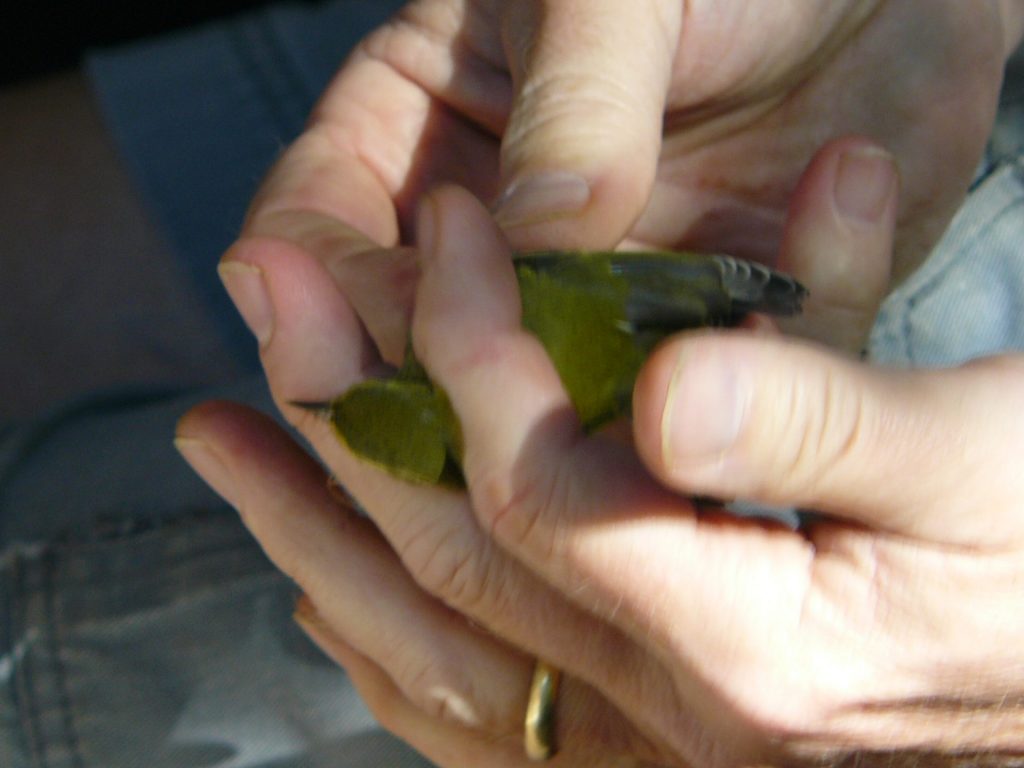
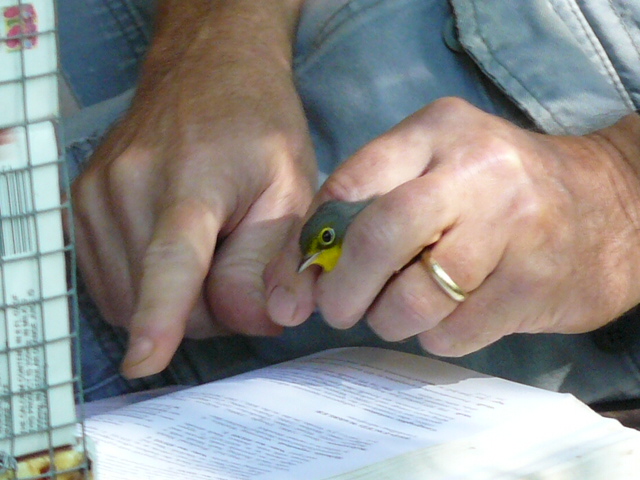
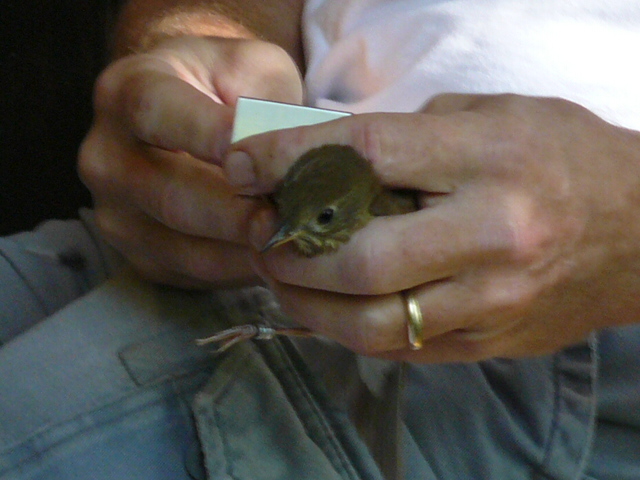
But banding has many scientific merits well beyond population estimates. Most of what we know about the lifespan of various bird species, about their molting cycles, and, most important, about their migratory habits comes from many years of banding data. Knowledge about the migratory whereabouts of birds is crucial, as many of our most popular species (orioles, tanagers, warblers, thrushes) spend more time outside of the U.S. then in it. Thus, any efforts at habitat conservation in our country could all fall flat, if they aren’t matched by similar efforts on birds’ Central and South American wintering grounds. All of the information gathered by banders throughout the western hemisphere is housed, in fact, right here in Maryland. The North American Bird Banding Laboratory is situated at the Patuxent Wildlife Research Center in Laurel. Not only do they oversee the stringent licensing requirements of who may or may not handle wild birds legally, but every 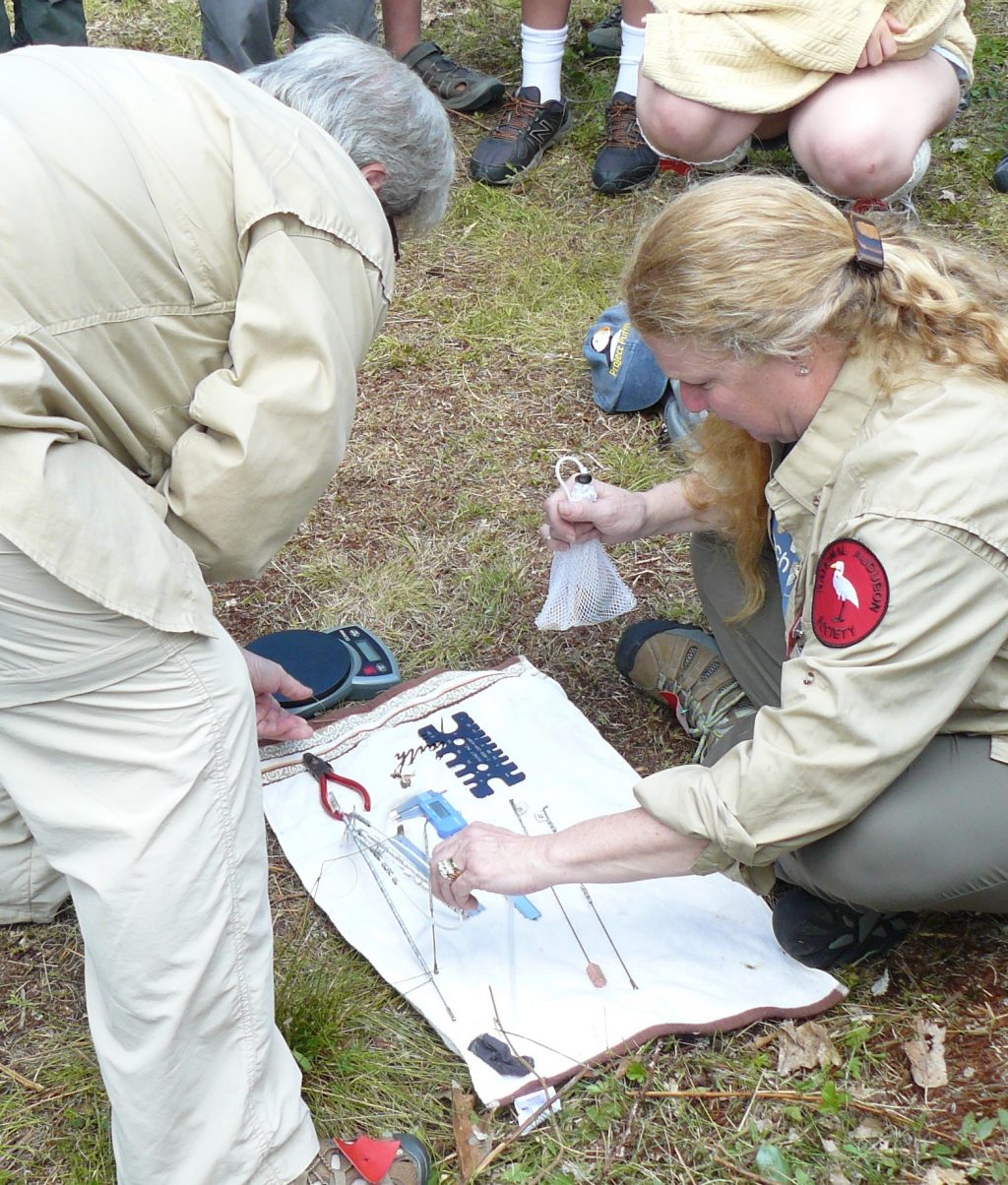 single band number that is placed on any bird’s leg goes directly into their database, along with associated information about that bird, such as gender, age (when possible), wing chord measurements, weight, estimates of body fat, any signs of parasites, etc. In recent years, with the advent of tiny satellite-based geo-tracking devices, scientists have been able to acquire fine-grain details about where birds stopover during migration, how long they stay there, and whether they deviate in any predictable way from a direct path to get there. By taking small blood samples from captured birds, toxicologists
single band number that is placed on any bird’s leg goes directly into their database, along with associated information about that bird, such as gender, age (when possible), wing chord measurements, weight, estimates of body fat, any signs of parasites, etc. In recent years, with the advent of tiny satellite-based geo-tracking devices, scientists have been able to acquire fine-grain details about where birds stopover during migration, how long they stay there, and whether they deviate in any predictable way from a direct path to get there. By taking small blood samples from captured birds, toxicologists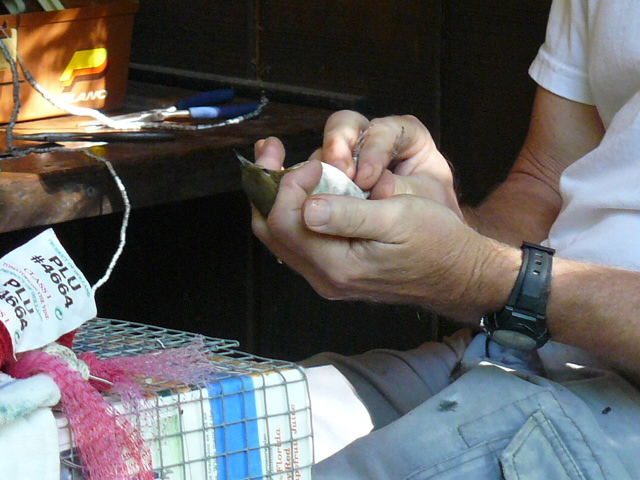 can investigate potential exposure to contaminants and epidemiologists can study diseases that birds might transmit to other individuals or even other species–like avian flu. And plastic color bands allow scientists–with assistance from the growing corps of volunteer citizen scientists–to document the habits and behaviors of individual birds, as they can be distinguished from other conspecifics at a safe distance, through either binoculars or a spotting scope.
can investigate potential exposure to contaminants and epidemiologists can study diseases that birds might transmit to other individuals or even other species–like avian flu. And plastic color bands allow scientists–with assistance from the growing corps of volunteer citizen scientists–to document the habits and behaviors of individual birds, as they can be distinguished from other conspecifics at a safe distance, through either binoculars or a spotting scope.
Truly, much of what we know about ornithology stems from the banding efforts of several generations of scientists before us. What I know from personal experience is that banding also has immeasurable intangible benefits, far beyond the science. My early exposure to banding led to a passion that has filled my life with so much joy and wonder for over four decades. I’m quite blessed to have been lucky enough to share that interest with both my parents and my own children. And I am not alone. I know, for instance, that Georgetown University professor (and former director of Smithsonian’s Migratory Bird Center) Pete Marra, who was one of our amazing speakers in Irvine’s summer Eat, Drink, & Learn lecture series, was first captivated by birds in the same way–tagging along, as a kid, at a local Nature Center’s banding facility. And to this day, I still occasionally bird with an old friend from PA, who also caught the ‘birding bug’ at the same little banding facility north of my hometown. It will be a long road to get there, but one of my ultimate goals in this new position is to bring bird banding back to Irvine. There’s a ton of interesting science to investigate–for instance, what explains the incredible (almost unparalleled in the Mid-Atlantic, actually) numbers and diversity of overwintering sparrows in our meadows? But, just as significant, there are a ton of children who need to be inspired to care deeply about birds and all of the wonders of nature. The future of our Earth depends upon it. We adults aren’t having a great deal of success turning the next generation on to the great outdoors; after all, we have video games and social media with which to compete, and, more often than not, we’re losing that battle. But I’m living proof and a firm believer that a bird in the hand can always do the trick! –BR
[Note: Click here for a lovely short video of the banding process in action.]
